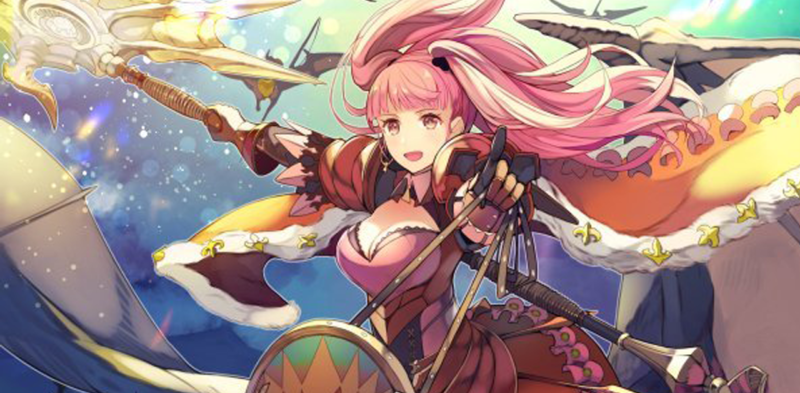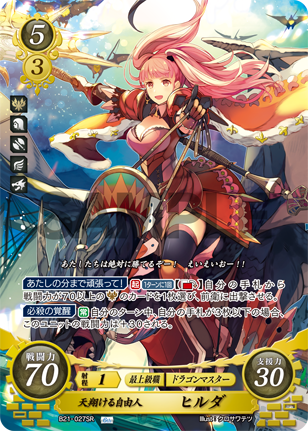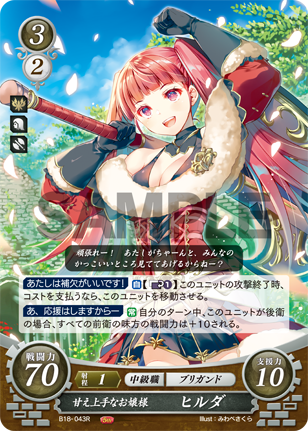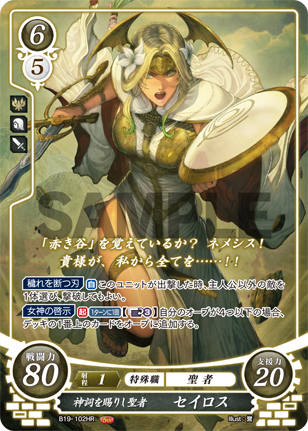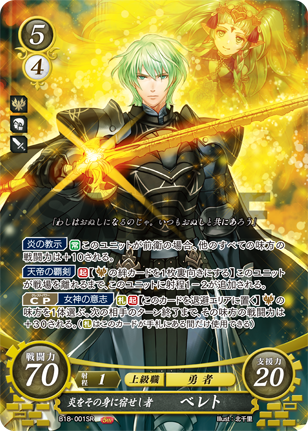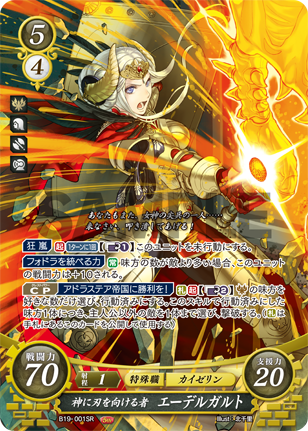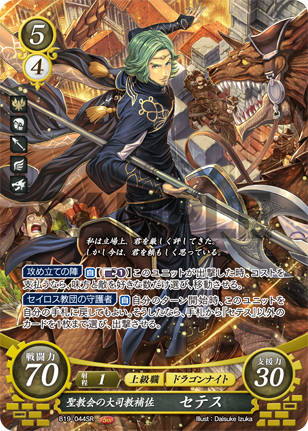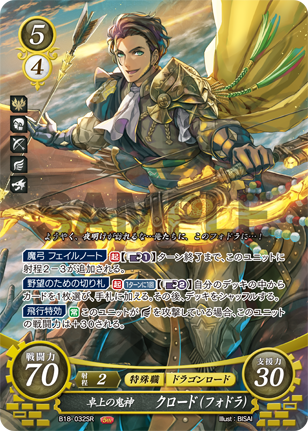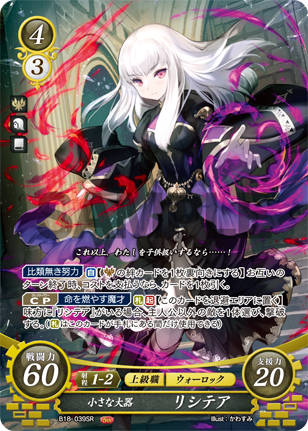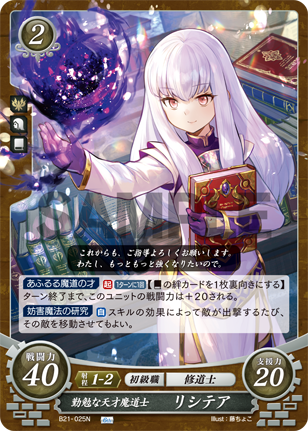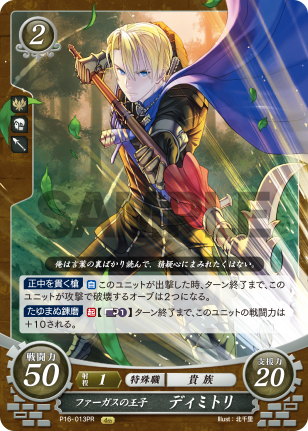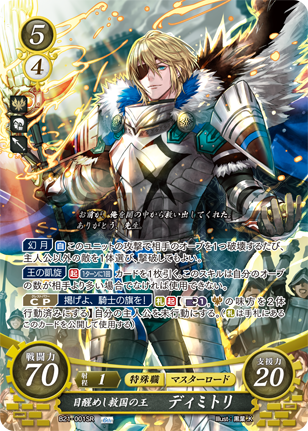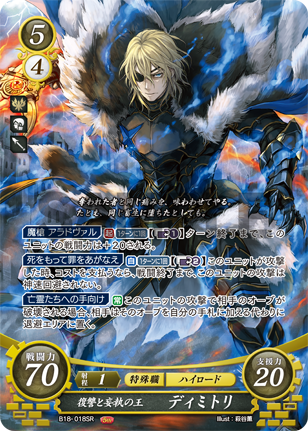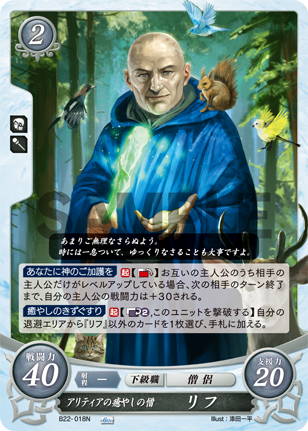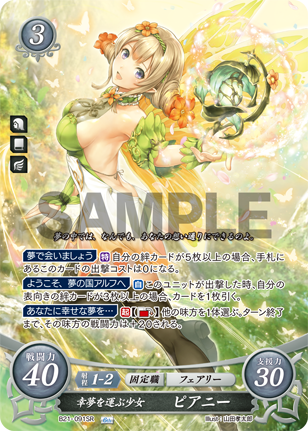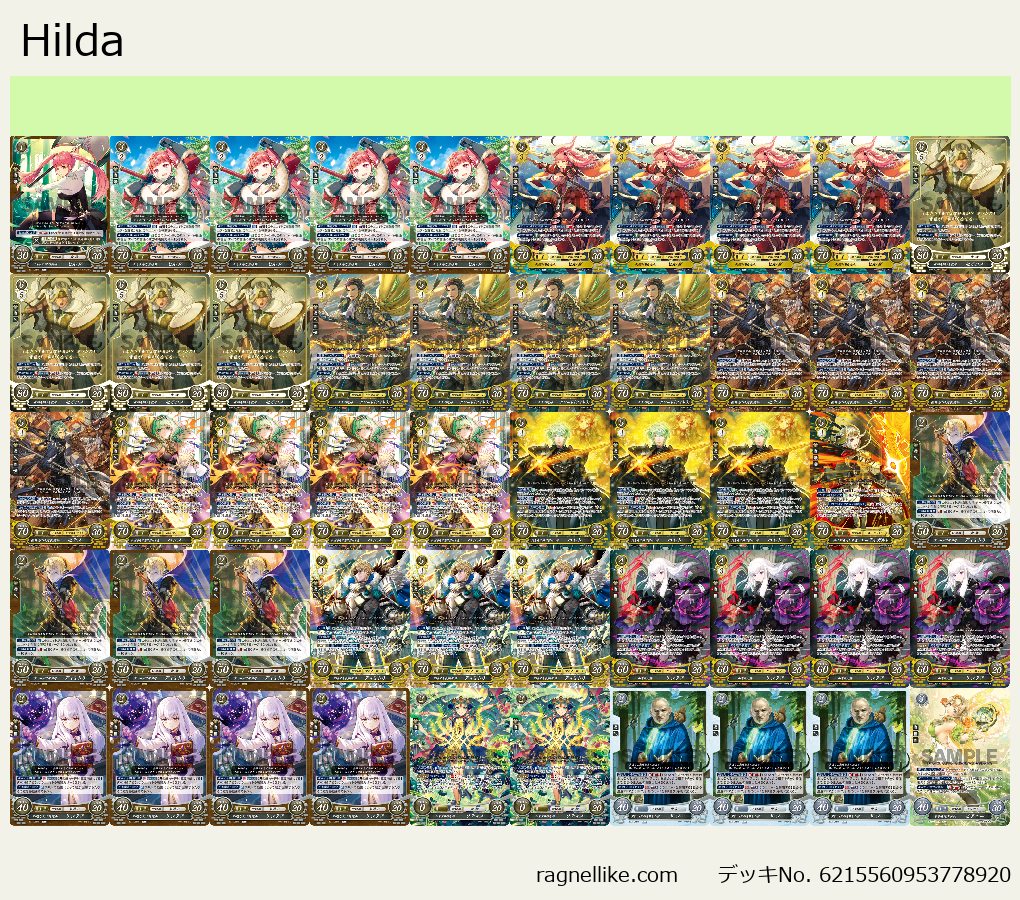Fire Emblem Cipher Primer – Hilda
Hilda is one of the more entertaining “Three Houses” characters, for lack of a better term. She’s whiney and complains about doing work, often passing the responsibility onto whoever she can beguile into it. She totes one of the highest strength growth rates in the game though, often leading to her being an absolute monster of a unit if the player chooses to invest in her. Her Cipher counterparts perfectly mirror these qualities about her, creating a very unique and fun toolbox deck that can turn out 5 or 6-cost threats as early as turn 3.
Her final promotion is a base 70 3-cost/5-deploy with two different effects. First, by exhausting herself, Hilda can deploy one other [brown] unit from the player’s hand to the front line, as long as it has a power value of 70 or more.
Her second ability is a continuous effect that’s only active during the player’s turn, where she gains +30 power as long as she has 3 or less cards in hand.
The deployment effect is what you’ll typically want to build Hilda around, as just hitting big numbers really isn’t all that impressive when it’s limited to just the player’s turn, and Hilda’s deployment effect is one of the easiest in the game to do consistently. She’s limited to other Three Houses units for her options, but there are more than enough of those that she’s not exactly low on them.
The +30 boost is more of a game ender than anything. Hilda can’t really recover her hand after using her effect, and only a handful of her deployable targets have effects that restock for her. The boost itself is a very cute nod to her broken growth rate in her game of origin, but it also serves as a way to try and finish your opponent off after your options have started to run low.
Hilda’s bridge is a 2-cost/3-deploy base 70 that also has two different effects.
First, when she attacks and enemy, she can move herself to the backline after combat by flipping one bond over.
Then, while she’s in the backline during the player’s turn. All of her frontline allies gain +10 attack.
This one is a very mixed bag. You absolutely want to run it, because 2-cost 70s are extremely rare to see, and also extremely hard to get over. The downside is that this version of Hilda only has 10 for her support value, compared to the 30s her final promotion and base do. This version of Hilda can also make for a very solid ender, depending on the situation. If your opponent is low on both cards and orbs while you have an established field, it’s often beneficial to promote into Barbarian Hilda, swing, move her back, and then let the other units in your front row take advantage of the +10 boost to help them secure hits or dodges.
Hilda’s 1-cost is a base 30 that comes with a movement skill limited to [brown] cards. She also has a rescue support effect, but lacks the typical flier typing associated with these particular stats and effects. There’s not much to say about this one other than you don’t want to be sitting on her for too long. The quicker Hilda moves up the ranks of her promotions, the safer she’ll be. Hilda’s general time to shine is in the mid-game when she can push ahead of most other decks. She’s very susceptible rush without proper defensive cards to help her out, and you typically want to always mull your hand with Hilda if you don’t open with any promotion copies of her.
So, what cards do you want to run in Hilda? Mostly high costs. Hilda doesn’t really tempo in the same way most decks do. Depending on what kind of build you go with will determine your choices, but expect to run a healthy amount of high-cost cards since you’ll ideally be throwing them out early through Hilda’s effect.
A few good staples Include the following:
Seiros, for being a base-80 that just destroys any non-MC enemy unit on play. She also has an orb recovery effect, but it’s so costly that you shouldn’t really plan on using much, if ever at all.
Set 18 Byleth is able to turn himself into a ranged attacker for the cost of one brown bond, and gives a board-wide +10 boost to everything as long as he’s in the frontline. He can also give a +30 boost to one unit that last throughout both player’s turns via his Crest Power. This gives Hilda a solid defense choice early on if you don’t see any promotion.
Set 19 Edelgarde for being able to refresh herself for the cost of one bond, as well as having a crest power that lets you destroy non-MC enemies on the field. In a proper combo, you can get 4 attacks against an enemy with Just Hilda, Edelgarde, and a Sothis that’s used her Crest Power ability.
Set 19 Seteth, because he can freely move ALL ally and enemy units around when he’s deployed, disrupting your opponent’s strategies while being able to move Hilda out of harm’s way. If he survives through the enemy’s turn, he can then return to hand and tag out with a different high-cost brown unit before getting played again. He’s also a flier, so he comes with a nice 30 support in combat.
And finally, Set 18 Calude, as he can pull whatever game-ending card Hilda needs and can either be deployed by her effect up front, or naturally into the backline. 5-cost is a bit pricey, but when most of your deck is 5 or more, he kind of fits right in. I really can’t understate how powerful his search ability is, since he can grab any card from the player’s deck for 2 bonds. He lets you get away with running lower numbers of situational plays like Sothis, or guarantees you’ll have an Edelgarde or Byleth in Hand should the situation require it.
I feel that regardless of whatever other cards you choose to run in Hilda, these 5 should be included in some capacity. They all provide incredibly strong effects and are almost always good choices to deploy.
Now, if we’re going to talk about more unique options, then here are a few deck lists to try. This particular list is one I was running during the last few months of the game. It mostly revolves around Using set 19 Byleth to deploy cheaper 2-costs and then hopefully hit their higher-cost promotions through her effects. In a perfect combo, you can go from a field of only Hilda to 4 units, 3 of them with 70 power or more, on turn 3. At worst, you’ll just end up with Hilda, Byleth, and some kind of utility 2-cost.
You can float around with your 2 costs, but Lysithea is invaluable since she helps with a lot of Hilda’s weaknesses. Her 2-cost allows the player to move enemies that are deployed through effects, forcing your opponent into awkward setups if they’re running an effect-heavy deck. Her promoted form also has multiple great effects. Such as letting you flip one [brown] bond at the end of each player’s turn to draw a card, and having a Crest power that let’s you discard her to blow up any non-MC unit while you control a Lysithea in the field.
Lysithea can’t be deployed via Hilda’s effect, but you probably shouldn’t be putting a squishy mage up front in the first place.
Dimitri also makes for an incredibly powerful deploy off Byleth. His 2-cost Arena promo destroys two orbs instead of one on the turn he’s played, and can flip a bond to gain +20 until the end of the turn. He also has several incredibly strong final promotions that Byleth can pull, or Hilda can play, that make him a great beater. In particular, his set 21 can destroy additional enemy units via his battle effect, and he also gives the player a costless draw if they have equal or more orbs than their opponent.
Hilda typically doesn’t want to color splash, since her main gimmick is rooted within [brown]. That’s not to say she can’t, but you’ll want to be using smaller engines that either aren’t color reliant or don’t care about being deployed from the hand. She does gain benefits from a lot of colorless staples. Much like with Zephiel, Wrys can really help out early on for Hilda by giving her a fighting chance. His +20 boost can keep Hilda above 1-cost threats, and his heal effect can set up either Hilda for her promotion, or grab back a unit to deploy with her. Hilda can also benefit off a lot of the elf units to pick up her slack in some areas. Plumeria is an excellent 2-cost option that can destroy annoying low-cost units and stall out deploys on higher ones, Freyer gives access to ramp, and can potentially lockdown MCs with 80 or more power, and Peony gives extra draw power. Hilda doesn’t need to flip bonds for her key skill, so chances are the 3 face-up requirement for Peony will be live when you’d be able to play her.
Here’s the main Hilda build I’ve been running for the past few months. It pretty much follows along with everything I’ve included in this guide, but you can change around your higher cost units as you see fit. Hilda’s toolbox can be a little restrictive because of how small brown’s card pool is, but there are certainly enough interesting options out there to catch people off guard.
If you’re looking for a very straight-forward toolbox deck, you can’t go wrong with Hilda.
